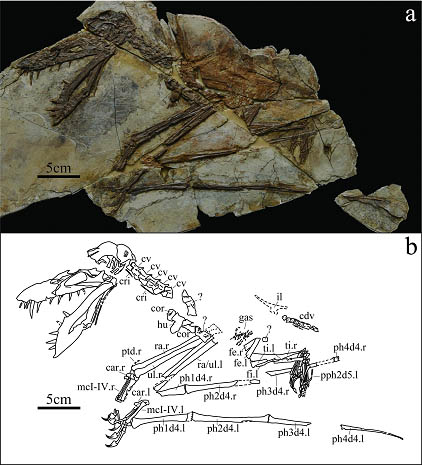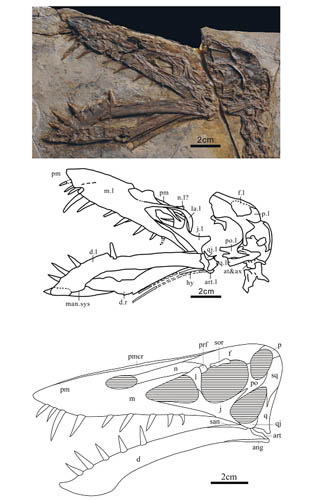New Scaphognathid Pterosaur Found from Western Liaoning, China
The research of Chinese pterosaurs has made remarkable contributions to the study of those flying reptiles. Most specimens were unearthed from the Yixian and Jiufotang formations of western Liaoning, China. More recently, some pterosaur materials are found in the region of Linglongta at the Jianchang County, western Liaoning. Dr. Wang Xiaolin, a research professor at the Institute of Vertebrate Paleontology and Paleoanthropology (IVPP), Chinese Academy of Sciences, and his collaborators from China and Brazil, described a partial skeleton of a new pterosaur, Jianchangnathus robustus gen. et sp. nov. from a locality near Linglongta, Jianchang County,western Liaoning, China, as reported in the journal of Historical Biology (Vol. 24, No. 1) in February 2012, demonstrating a larger diversity in the pterosaur fauna of the Linglongta region so far dominated by the non-pterodactyloid clade Wukongopteridae.
The holotype of Jianchangnathus robustus is preserved in a slab of light grey shale. The specimen is composed of a partial skeleton with the skull and the lower jaw that lacks most of the vertebral column (except for part of the neck and a few caudal vertebrae), portions of the wings and most of the hind limbs (apart from for the feet). Humerus, shoulder girdle and pelvis are very incomplete.
There is debate about the correct stratigraphic placement and consequent age of those deposits where the new specimen was unearthed. Some researchers advocate that those layers represent the Daohugou Bed (Formation), whereas others regard them as part of the Tiaojishan Formation that has been assigned to the Middle Jurassic, Late Jurassic or Late Jurassic- Early Cretaceous.
The new species shares several features with the non-pterodactyloid Scaphognathus from the Late Jurassic deposits of southern Germany, such as a deep anterior end of the lower jaw, a piriform lower temporal fenestra with the ventral margin broader than the dorsal one and the interalveolar spacing of the maxillary teeth about three alveolar spaces, allowing its assignment to the Scaphognathidae.
The main diagnostic features of Jianchangnathus robustus include the large maxillary process of the jugal, the convex alveolar margin of the lower jaw and the procumbent disposition of the first three pairs of dentary teeth. The new taxon also differs from Fenghuangopterus lii, which comes from the same deposit and is here regarded as Scaphognathidae incertae sedis, mainly by the lower number of teeth and several proportions of the wing elements.
“Beside wukongopterids, only Fenghuangopterus lii has been described from those deposits so far and was regarded to be a member of the Scaphognathinae. Jianchangnathus robustus can be unequivocally assigned to clade Scaphognathidae”, said the first author of the study CHENG Xin, a paleontologist graduate student of the IVPP, “The new find increases the diversity of flying reptiles from this region, indicating a large potential of those deposits for the study of non-pterodactyloid flying reptiles that lived comparatively close or at the Jurassic–Cretaceous boundary.”
This study was supported by the National Science Fund for Distinguished Young Scholars, the National Basic Research Program of China (973 Program), the Funda??o Carlos Chagas Filho de Amparo à Pesquisa do Estado do Rio de Janeiro, and the Conselho Nacional de Desenvolvimento Científico e Tecnológico. 
Fig.1: Holotype of Jianchangnathus robustus (IVPP V16866), (a) Photo and (b) drawing of the nearly complete skeleton. (Image by CHENG Xin) 
Fig.2: The skull of Jianchangnathus robustus (IVPP V16866). (Image by CHENG Xin)
Reference:
Xin Cheng, Xiaolin Wang, Shunxing Jiang & Alexander W.A. Kellner (2012): A new scaphognathid pterosaur from western Liaoning, China, Historical Biology: An International Journal of Paleobiology, 24:1, 101-111.
http://dx.doi.org/10.1080/08912963.2011.635423
Corresponding author:
Xiaolin Wang
Institute of Vertebrate Paleontology and Paleoanthropology
Chinese Academy of Sciences, P.O. Box 643
Beijing 100044, China
Email: wangxiaolin@ivpp.ac.cn
Download attachments: